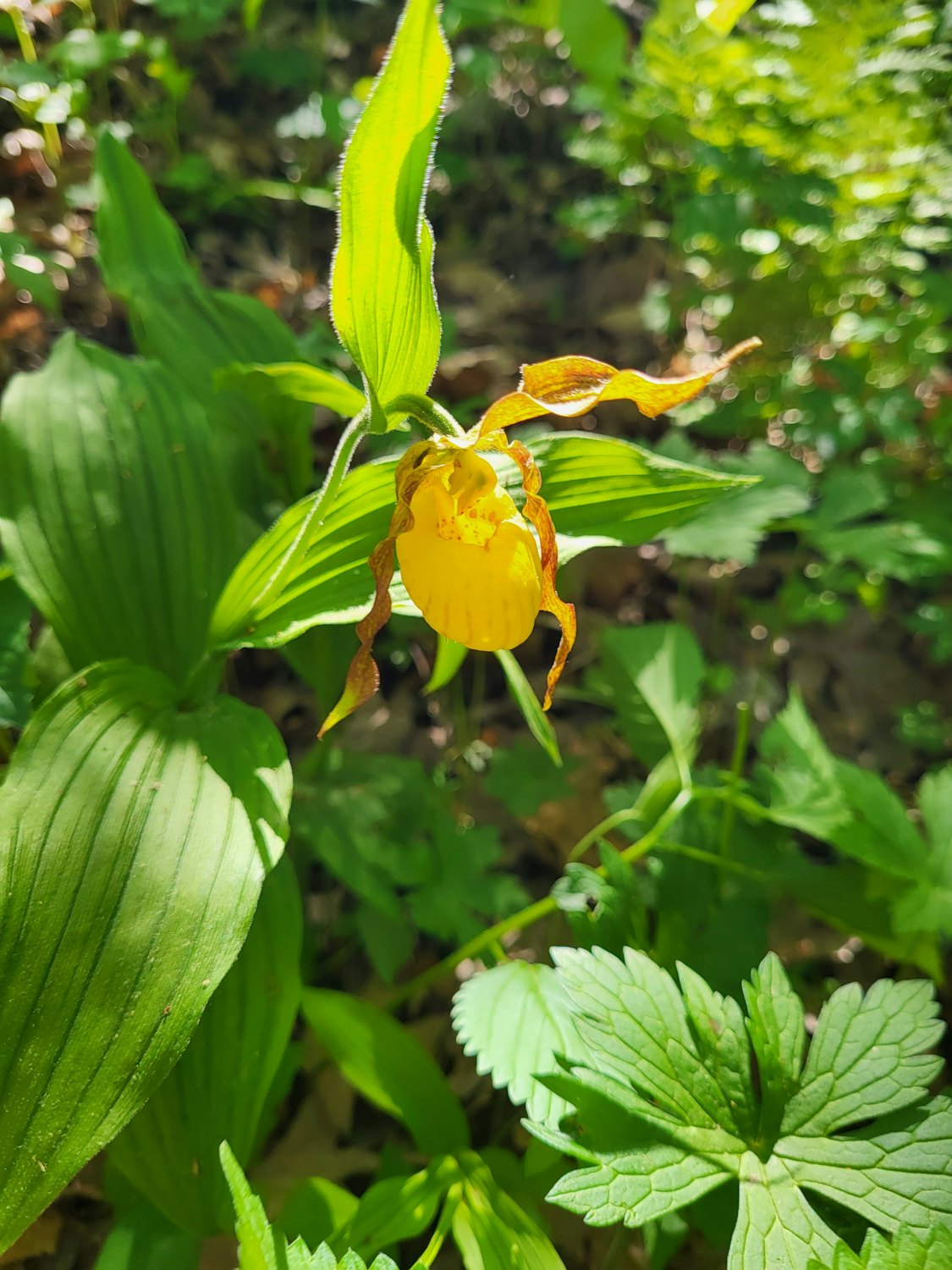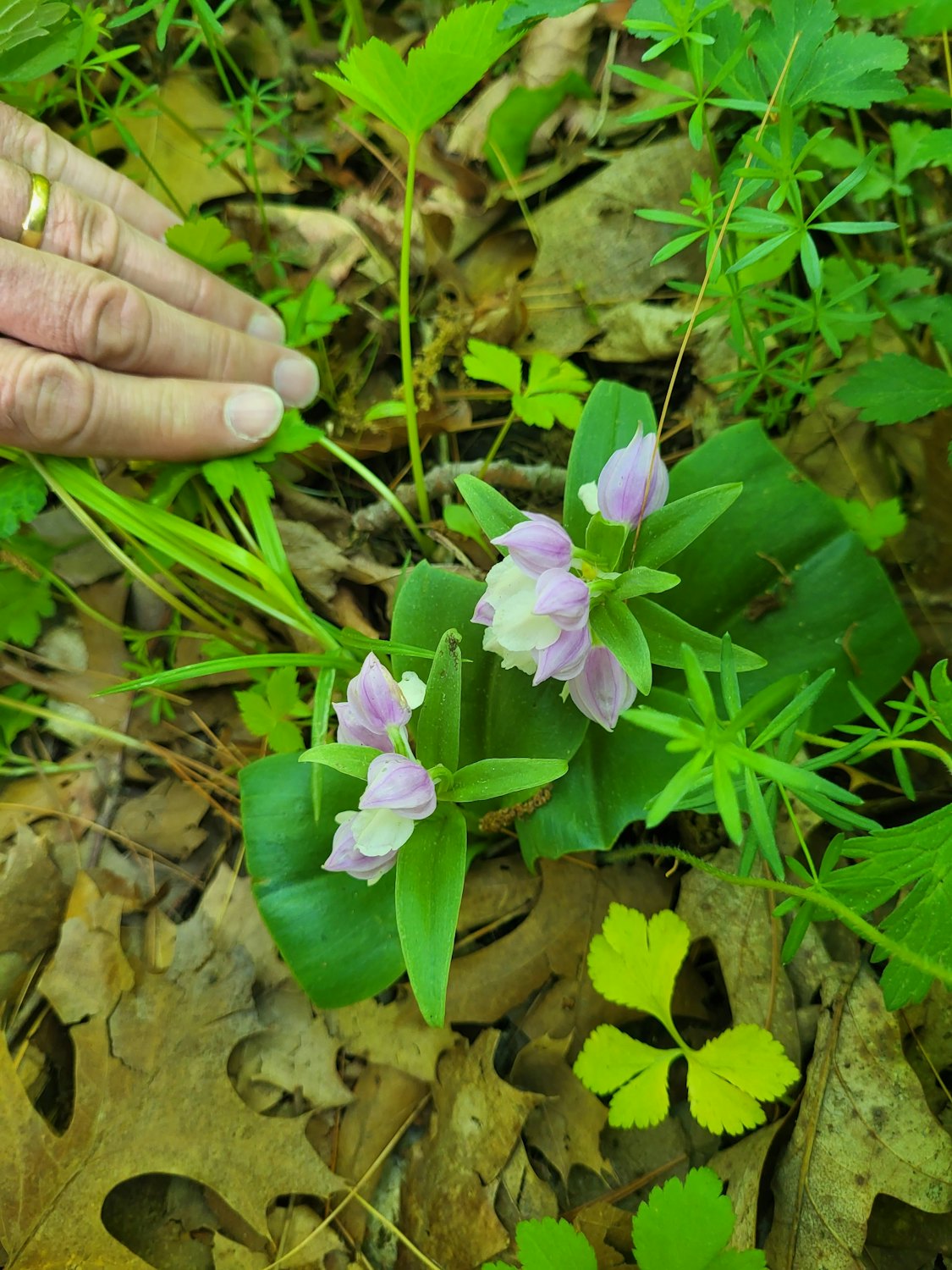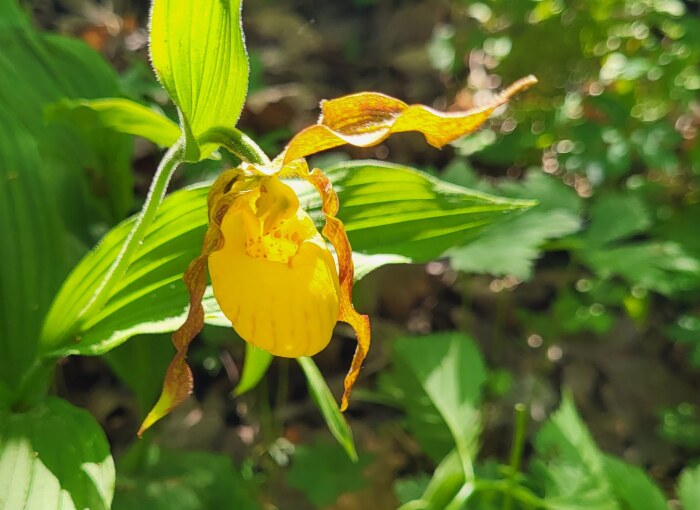Kara Grady is an amatuer botanist and wildflower enthusiast based in eastern Iowa. Her work has been published in the Erythronium newsletter of the Iowa Native Plant Society. When she’s not going on rare flower adventures, she can be found reading the latest botanical books or attending prairie seminars.
“I think I’ll put a cage around it.”
It was a beautiful blue day in the middle of May, and Chris Edwards and I were both staring at the one lesser yellow lady slipper blooming in his family’s woodland plot. While I stared in utter rapture, Chris looked slightly grim, and perhaps for good reason. This is the last clump of the slipper that still exists since his grandparents bought the woodland in 1963. He blames ravenous deer for their disappearance.
Hungry deer are just one of the many challenges Iowa’s orchids face in their struggle for survival.
They’ve been dug up by amateur plant enthusiasts whose intentions can decimate an entire small population, removing sources of genes that eventually cause the death of what remains. Native orchids also require an extremely delicate balance of soil fungi and environmental factors that have caused most transplanting efforts to fail. More than half of the 30 orchid species native to Iowa are considered endangered or threatened in the state.
Some have not been observed since the 1900s, suggesting that they have been extirpated from Iowa. More seem fated to join them, with showy lady’s slipper, small green wood orchid, and others disappearing in the last few years, according to Dr. Tom Rosburg’s recent talk on native orchid identification.
I had my first encounter with what I had always assumed was a tropical flora at the Neal Smith National Wildlife Refuge. My fellow intern Anna Ivarson-Delfuente had decided to revitalize “a previous intern’s 1999 survey of the species: Showy Orchis (Gaeleris spectabilis) and Purple Twayblade (Liparis lilifolia). The goal of the original survey was to get an estimated number of total individual orchids in the Buzzard Head Unit, then compare canopy cover to the health of the orchids” (Ivarson-Delfuente 2022).
We spent afternoons in May 2022 sticking our heads under invasive buckthorn, multiflora rose, and honeysuckle looking for the distinct two leaves that marked where a showy orchis would appear. Anna wanted to see how the fluctuation in management of the remnant had affected the orchid populations since the original 1999 survey.
Though I left before the project was completed, I became curious about Anna’s findings. She shared with me that of the estimated 293 orchids the original interns had found, she and others had rediscovered an estimated 138, but only 24 flowered and were positively identified as showy orchis. None of the purple twayblade were identified (Ivarson-Delfuente 2022).
These preliminary results created a spiral of more and more questions that I am still pondering. What caused the disappearance of the purple twayblade while the showy orchis remained a viable population? Was it differences in shade and moisture levels created by the spread of invasive plants? Was it another case of hungry deer?
Looking at the state of Iowa’s orchids, the questions become starker. Is climate change affecting our soil substrate in such a way that the fungi most orchids need to survive is becoming obsolete? Are frequent drought years robbing moisture-loving orchids of desperately needed rain? Or are species such as showy orchis remaining dormant in the face of rising temperatures?
Perhaps the answer lies in another direction: people just aren’t looking. After Chris shows me the two blooming showy orchis he’s found, he reflects on how this population also seems to fluctuate throughout the years. These are the only ones he’s found so far.
Hiking along another trail, Chris plows ahead. My legs feel rubbery and I take a moment to rest, glancing down at my feet.
“Orchids! Orchids!”
And hope for another year.
Lesser yellow lady’s slipper (Cypripedium caleolus) found in Jones County, photo by Kara Grady:

Showy orchis (Gaeleris spectabilis) found in Jones County, photo by Kara Grady:

Editor’s note from Laura Belin: Bleeding Heartland author Marla Mertz featured showy orchis and two of Iowa’s orchids that bloom in the autumn in 2016. Katie Byerly featured small white lady’s slipper in 2018.
References
Ivarson-Delfuente, Anna. “Orchid Article.” 2022.
Runkel, Sylvan T., and Alvin F. Bull. Wildflowers of Iowa Woodlands. 2nd ed., University of Iowa Press, 2009.
“Native Orchid Identification with Dr. Tom Rosburg.” Golden Hills Resource Conservation & Development, uploaded to YouTube by Golden Hills RC&D, March 31, 2023.


3 Comments
I really appreciate this post...
…and among other things, appreciate the mention of the deer problem.
Decades ago, right after moving to Iowa, I was under the illusion that deer were managed according to ecological principles and the carrying capacity of the landscape. The truth soon became evident. Deer management in Iowa is based on politics, money, and sociology. And it is further complicated by the general difficulty of controlling deer numbers in urban/suburban landscapes.
Orchid populations are among the casualties. Deer have a known preference for orchids and lilies. And there are other wildflower casualties caused by deer densities that are too high, and little oak trees too. From what I’ve read, when there are more than nine or ten deer per square mile, the problems begin. A botanist friend thinks that number should be six or seven.
Many areas of Iowa have higher deer densities. And the last I heard, the DNR had decided that urban/suburban deer densities start to be considered a problem at around thirty-five deer per square mile, a far higher density than when serious damage begins.
An Iowa forester took me on a local tour a few decades ago and showed how to recognize deer damage. Suddenly I was looking at a world of hurt that I hadn’t seen. Around that same time, I heard deer horror stories from a friend who knew and loved native orchids and saw some populations being wiped out by high deer numbers on certain tracts of Iowa public land.
One of the many awful things about climate change is that it is sucking all the oxygen out of the room in regard to the environment. It is such a huge important issue that for some people, it seems to be the only environmental issue. Unfortunately, other Iowa environmental problems haven’t stopped. Orchid loss and deer damage are among them.
At least lethal deer control is still accepted in Iowa. I spoke with a very nice woman several years ago who said that she’d rather see all of the last showy orchids disappear from a local Iowa natural area than see a single deer killed. If that attitude ever becomes widespread, as I’ve heard it is in certain parts of some eastern states, Iowa’s deer and wildflower challenges will become even bigger.
PrairieFan Wed 14 Jun 11:47 AM
I suspect the deer
for the disappearance of Solomon’s seal and bellwort near my house. We used to see them every year but deer would eat them just as the flowers were appearing. Eventually they stopped growing back.
Laura Belin Wed 14 Jun 5:30 PM
Bellwort is described as "preferred forage for deer" on one Arkansas wildflower site...
…so I’m guessing the same would be true here. Solomon’s seal is considered more deer resistant, but “deer sometimes try them.” And hungry deer seem unfortunately open-minded sometimes. I’m sorry about your flowers, and I know the feeling. Prairie larkspur is supposed to be deer resistant, but someone forgot to tell some deer in my area.
PrairieFan Thu 15 Jun 10:55 PM